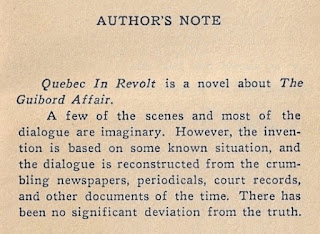Herman Buller
Toronto: Swan, 1966
352 pages
The cover has all the look of a 1960s polemic, but Quebec in Revolt is in fact a historical novel. Its key characters are depicted on the title pages:
Here's what happened:
In 1844, Montreal typographer Joseph Guibord helped found the Institut canadien. An association dedicated to the principles of liberalism, its library included titles prohibited by the Roman Catholic Index – the Index Librorum Prohibitoru. These volumes, combined with the Institut's cultural and political activities, drew the condemnation of Ignace Bourget, the Roman Catholic Bishop of Montreal. In July 1869, Bourget issued a decree depriving members of the sacraments. Guibord died four months later.
Here's what happened next:
Guibord's body was transported to a plot he'd purchased at Montreal's Catholic Notre-Dame-des-Neiges Cemetery, only to be refused burial by the Church. The remains found a temporary resting place at the Protestant Mount Royal Cemetery, while friend and lawyer Joseph Doutre brought a lawsuit on behalf of the widow Guibord. In 1874, after the initial court case and a series of appeals, the Judicial Committee of the Privy Council ordered the burial. In response, Bourget deconsecrated Guibord's plot.
The third attempt, on 16 November, was accompanied by a military escort of over 1200 men. Guibord's coffin was encased in concrete so as to protect his body from vandals.
 |
| Louis Perrault & Co, c.1869 |
"Skin and bone had given way to flesh and curves," Della recovers and grows to become a headstrong young woman. Buller makes much of her breasts. Ever one to buck convention and authority, Della spurns marriage, has a lengthy sexual and intellectual relationship with journalist Arthur Buies, and ends up living openly with Joseph Doutre ("Josef" in the novel). Truly, a liberated woman; remarkable for her time.
Joseph Guibord's entry in the Dictionary of Canadian Biography informs that he and Henriette, a couple Buller twice describes as childless, had at least ten children. The entry for Joseph Doutre, whom the author portrays as a lifelong bachelor, records two marriages.
The Swan paperback quotes Al Palmer, author of Montreal Confidential and Sugar Puss on Dorchester Street):
 |
| The Gazette, 19 November 1965 |
About the author: Herman Buller joins Kenneth Orvis and Ernie Hollands as Dusty Bookcase jailbird authors. A lawyer, he rose to fame in the 'fifties as part of a baby-selling ring.
 |
| The Gazette, 13 February 1954 |
 |
| La Patrie, 11 February 1954 |
I hadn't heard of the Buller Affair (as I call it) until researching this novel, despite it having been dramatized in Le berceau des anges (2015) a five-part Series+ series. Buller (played by Lorne Bass) is mentioned twenty-two seconds into the trailer.
Quebec in Revolt was first published in 1965 by Centennial Press. If the back cover is to be believed, McKenzie Porter of the Toronto Telegram describes that edition as a "Canadian best seller." I've yet to come across a copy.
As of this morning, seven copies of Quebec in Revolt are listed for sale online. At US$6.00, the least expensive is offered by Thiftbooks: "Unknown Binding. Condition: Fair. No Jacket. Readable copy. Pages may have considerable notes/highlighting," Take a chance! Who knows what will arrive!
There are two Swan copies at US$8.00 and US$12.45. Prices for the Centennial edition range from US$10.00 (sans jacket) to US$24.00.
There hasn't been a French translation.
Is it any wonder?






























